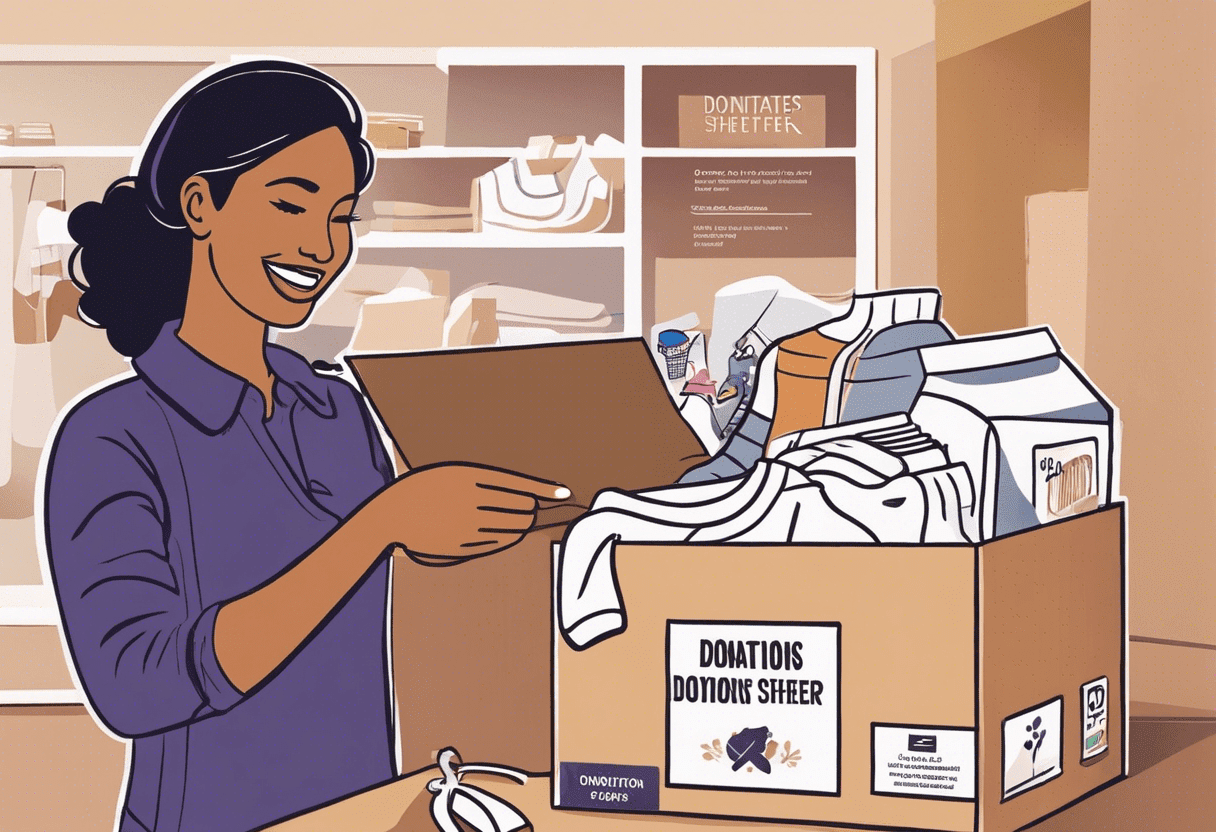
How to Donate Clothes to Women Shelters: A Step-by-Step Guide

Donating clothes to women’s shelters is a simple yet impactful way to support survivors of domestic violence and help them start anew. In this step-by-step guide, we’ll show you how you can make a difference through your clothing donations.
Why Donate Clothes to Women’s Shelters?
Survivors of domestic violence often escape their abusers with nothing but the clothes they’re wearing. Women’s shelters play a crucial role in providing these individuals with the essentials they need to rebuild their lives and regain their independence. By donating items such as clothing, shoes, accessories, and other necessities, you can directly contribute to their healing journey.
Step 1: Find Women’s Shelters in Your Area
The first step in donating clothes to women’s shelters is finding shelters near you that accept donations. Here are some ways you can locate them:
- Online Search: Use search engines or online directories to find women’s shelters in your area. Look for official websites or contact information that can provide details on their donation process.
- Local Directories: Check community resources such as phone books, community centers, or social service agencies for listings of women’s shelters.
- Word of Mouth: Reach out to friends, family, or local organizations that may have information about nearby shelters.
Step 2: Check Shelter Wish Lists
Once you’ve identified potential shelters to donate to, it’s important to check if they have any specific needs or wish lists. This ensures that your donations align with their current requirements and are truly beneficial. Here’s how you can find shelter wish lists:
- Shelter Websites: Visit the websites of the shelters you’re interested in and look for any mention of wish lists or donation guidelines. They may have an updated list of items they urgently need.
- Contact Shelters: Reach out directly to the shelters via phone or email and inquire about their specific donation needs. They’ll be able to provide you with detailed information on what items are currently in high demand.
Step 3: Sort and Prepare Your Donations
Once you know what items the shelters are looking for, it’s time to gather your donations and get them ready for drop-off or pick-up. Follow these tips for sorting and preparing your clothes:
- Check Condition: Ensure that the clothes you’re donating are clean, gently used, and in good condition. Shelters typically can’t accept items that are torn, stained, or excessively worn.
- Organize by Category: Sort your clothing donations into categories such as tops, bottoms, dresses, outerwear, etc. This makes it easier for both you and the shelter staff to handle and distribute the items.
- Packaging: If possible, fold or neatly pack the clothes in boxes or bags that are easy to carry. Labeling them by category can also be helpful.
Step 4: Donate Your Clothes
Now that your donations are sorted and prepared, it’s time to deliver them to the women’s shelters. Here are two common ways you can donate:
- Drop-off: Find out if the shelters have designated drop-off locations where you can personally bring your donations. This allows you to see the facility and potentially learn more about their work.
- Pick-up: Some shelters offer pick-up services for larger donations or if you’re unable to drop off the items yourself. Contact them in advance to arrange a convenient time and location for pick-up.
Step 5: Explore Other Ways to Help
While clothing donations are incredibly valuable, there may be additional ways you can support women’s shelters and their residents. Consider these options:
- Volunteer: Inquire about volunteer opportunities at the shelters. They may have specific roles or tasks where your time and skills can make a difference.
- Fundraising: Explore fundraising initiatives or events organized by the shelters. This could involve gathering monetary donations or hosting awareness campaigns.
- Advocacy: Learn more about the issue of domestic violence and become an advocate for survivors. Share resources, participate in discussions, or support policy changes that prioritize their safety.
Conclusion
Donating clothes to women’s shelters is a tangible way to show compassion and solidarity with those who have experienced domestic violence. Your contributions can help create a sense of normalcy and empowerment for survivors as they rebuild their lives.
Remember, even small actions can have a big impact. Start today by decluttering your closet and making a conscious choice to support women in need.”
1. Understanding the Significance of Your Donation

Helping Domestic Violence Survivors Rebuild
- Clothing donations can contribute to the recovery process of domestic violence survivors, allowing them to start anew.
- Having access to clean and appropriate clothing can help restore a sense of dignity and self-esteem for women in shelters.
Donating clothes to women’s shelters is a powerful way to support survivors of domestic violence as they rebuild their lives. These donations provide more than just material items; they offer a symbol of hope and renewal.
For many survivors, fleeing an abusive environment means leaving behind everything they own, often with only the clothes on their backs. By receiving clothing donations, these women are given the opportunity to start anew, free from the trauma of their past. This is where organizations like Grateful Garment come in, providing essential clothing items for survivors.
Restoring Dignity and Confidence
Moreover, having access to clean and appropriate clothing can significantly impact a woman’s sense of dignity and self-esteem while staying at a shelter. It allows them to feel comfortable and confident as they navigate through challenging times.
The simple act of being able to choose an outfit that reflects their personal style can be empowering, fostering a sense of normalcy in their lives amidst turmoil.
Therefore, your donation contributes not only to meeting a practical need but also plays a crucial role in supporting the emotional well-being of these women. Organizations like HandsOn San Diego work tirelessly to collect and distribute these donations, ensuring that every contribution reaches those who need it most.
2. Finding the Right Women’s Shelters to Support

When it comes to donating clothes to women’s shelters, it’s important to find the right organizations that are in need of your donations. Here are some steps to help you in your search:
- Research local women’s shelters: Start by researching women’s shelters in your local area. You can do a quick internet search or reach out to community organizations for recommendations. Make a list of potential shelters that you can further explore.
- Check shelter wish lists: Many women’s shelters have wish lists that outline the specific items they are in need of, including clothing. These wish lists can usually be found on the shelter’s website or by contacting them directly. Take the time to review these lists and see if your donations align with their needs.
- Look for donation calendars: Some shelters have specific donation calendars that indicate when they are accepting clothing donations. This is particularly important as shelters may have limited storage space and may only accept donations during certain times of the year. By checking their donation calendar, you can ensure that your donations will be received and used effectively.
- Consider volunteering opportunities: In addition to donating clothes, you may also want to consider volunteering your time at women’s shelters. Volunteering not only allows you to make a direct impact but also gives you a chance to learn more about the organization and its needs. Contact the shelters on your list to inquire about any volunteer opportunities they may have available.
Remember, every shelter is unique, and their needs may vary. It’s essential to do your research and find an organization that aligns with your values and goals. By finding the right women’s shelter to support, you can ensure that your clothing donations will have a meaningful impact on the lives of those in need.
3. Sorting and Preparing Your Items for Donation
When you donate clothing to women’s shelters, it’s important to make sure the items are in great condition. Here’s what you need to do:
3.1 Checking Your Clothes
- Look for stains, tears, or excessive wear that might make the clothes unsuitable for donation.
- Wash and iron the clothes so they’re clean and nice. Use mild detergents and avoid strong smells.
- Be careful with how you handle the clothes – fold or hang them neatly to keep them from getting wrinkled or damaged during transport.
By carefully checking each item, taking the time to clean and prepare them according to proper clothing donation etiquette, you’re showing respect for the people who will receive your donations. This extra effort ensures that the women and children getting the clothes will have access to high-quality items that can really help them.
Remember, the goal is to give gently used things that can make a real difference in someone’s life. Your work in checking and preparing your donations helps create a positive impact on the people supported by women’s shelters.
3.2 Prioritizing Essential Items for Women and Children
When you donate clothes to women’s shelters, it’s important to focus on items that women and children really need. Here are some things to consider:
1. Comfortable Undergarments and Socks
These items are often forgotten, but they’re crucial for women in shelters. Comfortable underwear and socks can make a big difference in how they feel every day.
2. Different Sizes and Styles
It’s important to have clothes that fit different body types and personal styles. The donated clothing should include a variety of sizes and styles so that every woman can find something she likes and feels good in.
3. Age-Appropriate Clothing for Children
When donating clothes for kids, make sure they’re suitable for their age. Having a range of sizes for different age groups ensures that all children in the shelter have clothes that fit them well.
To ensure that the donated items are of high quality, prioritize clothing that is in excellent used condition. Offer practical tips for sorting through your wardrobe and selecting items that are suitable for donation, with a focus on quality and relevance to the shelter’s needs. Provide guidelines on ensuring the clothes are in excellent used condition, including steps for cleaning and repairing if necessary. Emphasize the importance of only donating items that you would be comfortable giving to a friend.
By focusing on these essential items, you can make a real impact on the lives of women and children living in shelters. It’s not just about giving them clothes – it’s about giving them dignity and comfort during difficult times.
4. Packaging and Delivering Your Donations

Here’s what you need to do to package and deliver your donations:
- Pack securely: Use sturdy boxes or bags to ensure that the donated clothes are protected during transportation.
- Label clearly: Help the shelter staff by labeling the packages with basic descriptions of their contents (e.g., “Women’s Winter Coats – Size M”).
- Drop-off or pick-up: Choose whether you want to drop off your donations at the designated donation center or arrange for pick-up services.
- Follow protocols: If there are any specific requirements or protocols that need to be followed, make sure to adhere to them.
4.1 The Role of Women Giving Back Organization
Let’s take a moment to appreciate the amazing work done by Women Giving Back:
- They provide crucial support to women and children facing challenging times of crisis and transition.
- Through their clothing donation program, they address immediate needs while also empowering individuals to create a better future for themselves.
5. Other Ways to Make a Positive Impact
When it comes to supporting women’s shelters, donating clothes is just one way to make a difference. If you’re looking for other ways to contribute, consider the following guidelines:
- Volunteer your skills: Besides donating clothes, shelters often rely on volunteers to provide various services. Whether you have expertise in counseling, job training, or childcare, your skills can be invaluable in helping women rebuild their lives. Reach out to local shelters and inquire about volunteer opportunities that align with your interests and abilities.
- Organize fundraisers: Financial assistance is crucial for women’s shelters to continue providing essential resources and support. Consider organizing fundraisers in your community to raise money for these programs. You could host events such as bake sales, charity runs, or clothing drives to engage others in supporting the cause.
- Raise awareness: Use your voice and social influence to shed light on the challenges faced by homeless women and the importance of community support. Share stories of resilience and success from women who have benefited from shelters. Utilize social media platforms or local community forums to raise awareness about the issues surrounding homelessness and domestic violence.
By volunteering your time, organizing fundraisers, and raising awareness, you can play an active role in supporting women’s shelters beyond clothing donations. Remember that every contribution counts and has the potential to make a lasting impact on the lives of those in need.
“No one has ever become poor by giving.” – Anne Frank
Conclusion
Every small action can make a big difference in someone’s life. By donating clothes to local women’s shelters, you are directly helping women in need rebuild their lives and regain their independence.
So why wait? Take action now and donate clothes to your nearest women’s shelter. Your contribution can bring hope and support to those who need it the most.
donate clothing to women’s shelters
women’s shelter donations
clothing drive for women’s shelter
donate clothes for domestic violence survivors
women’s shelter support
charity organizations for women’s shelters
helping women in need with clothing donations
donate gently used clothing to women’s shelters
supporting women in crisis with clothing donations
clothing donation centers for women’s shelters
FAQs (Frequently Asked Questions)
What is the importance of supporting women’s shelters through clothing donations?
Clothing donations are crucial in helping women in need, especially those who are survivors of domestic violence. By providing clean and appropriate clothing, it can contribute to their recovery process and help restore a sense of dignity and self-esteem.
How can clothing donations contribute to the recovery process of domestic violence survivors?
Clothing donations can allow domestic violence survivors to start anew by providing them with the necessary items to rebuild their lives. Access to clean and appropriate clothing can help restore a sense of dignity and self-esteem for women in shelters.
What guidance can be provided for researching local women’s shelters in need of clothing donations?
You can research local women’s shelters in need of clothing donations by checking their wish lists and donation calendars. Additionally, consider volunteering your time at these shelters as another way to make a difference.
How should one assess the quality of clothing items for donation?
Check for any stains, tears, or excessive wear that may render the clothing unsuitable for donation. Launder and iron the clothes to ensure they are clean and presentable. Handle with care: Fold or hang the garments neatly to prevent them from getting wrinkled or damaged during transportation.
What are some practical tips for sorting through your wardrobe and selecting items suitable for donation?
Offer practical tips for sorting through your wardrobe and selecting items that are suitable for donation, emphasizing the importance of only donating items that you would be comfortable giving to a friend. Additionally, provide guidelines on ensuring the clothes are in excellent used condition, including steps for cleaning and repairing if necessary.
How should one package and deliver their clothing donations?
Pack the donated clothes securely using boxes or bags that are sturdy enough to withstand handling. Label the packages with basic descriptions of their contents (e.g., ‘Women’s Winter Coats – Size M’) to facilitate sorting at the shelter. Then, drop off the contributions at the designated donation center or arrange for pick-up services, following any specific requirements or protocols that need to be followed.







2 thoughts on “How to Donate Clothes to Women’s Shelters : A Step-by-Step Guide”